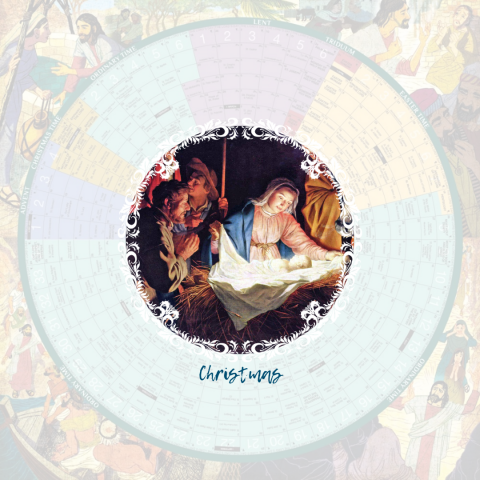
The Office of Catholic Schools wishes you and your family continued blessings throughout the remaining days of Christmas!
For much of the world, Christmas is a single-day celebration, immediately after which trees lose their honored place in the house, lights are boxed away, and carols of good cheer fade out. However, the Church celebrates the birth of Christ throughout the entire Christmas season, which officially culminates with the Feast of the Baptism of the Lord (January 8).
For many, a sigh of relief is in order: No rush to tear down decorations, feasting can continue, and for procrastinators, the window for gift-giving remains open. Let us give Christmas a more significant place in our lives as we carry on proclaiming the birth of our Savior.
One fitting way to continue celebrating Christmas is by reflecting on the nativity scene in our home. Rather than a mere decoration, the classic depiction of the Holy Family can serve as a prayerful icon, drawing us into the mystery of the Incarnation. Departing from the bright lights and glamor that usually adorn the Christmas season, the nativity scene depicts Christmas in its truest form. We see Joseph and Mary, exhausted from travel and surrounded by farm animals in a dirty stable. In a place of poverty, they look upon the greatest treasure the world has ever known: the newborn Christ.
In 2019, Pope Francis visited the site of the first nativity in Grecco, Italy. He reflected on the visit saying the following: “The Nativity scene has invited us to ‘feel’ and ‘touch’ the poverty that God’s Son took upon himself in the Incarnation. Implicitly, it summons us to follow him along the path of humility, poverty, and self-denial that leads from the manger of Bethlehem to the cross.” While continuing to look upon our nativity scenes, let us keep in mind the call to live humbly and meekly as Christ did.
Within the Christmas season, the Church provides us with several prominent feast days to acknowledge and celebrate along with the Nativity. See the list below and plan accordingly!
December 26 - St. Stephen, The First Martyr
Yesterday, as we heard in the first reading of the day, Stephen was stoned for his astute defense of Jesus Christ. Facing his death at the hands of an angry mob, Stephen looked to heaven and spoke his last words, “Lord Jesus, receive my spirit.”
December 27 - St. John, Apostle and Evangelist:
The “disciple whom Jesus loved,” John is believed to have written three New Testament epistles, the Book of Revelation, and the gospel account which most explicitly ascribes to Jesus his divine nature.
December 28 - The Holy Innocents, Martyrs
“When Herod realized that he had been deceived by the magi, he became furious. He ordered the massacre of all the boys in Bethlehem and its vicinity two years old and under, in accordance with the time he had ascertained from the magi” (Mt. 2:16). On this day, we honor the innocent life snuffed out by Herod, and we can pray in a special way for the unborn children victimized in our own time.
December 31 - Feast of the Holy Family
On this day we recognize the holiest of families: sinless Mary; Joseph, her most chaste spouse; and the Christ-child. “The Redeemer of the world chose the family as the place for his birth and growth, thereby sanctifying this fundamental institution of every society” (John Paul II).
January 1 - Solemnity of Mary, Mother of God
A day to honor Mary as the one who brought Jesus into the world. It is a solemnity in which we venerate our Blessed Mother, but more centrally, we recognize the Godman to whom she gave birth. Mary’s motherhood always points to the fact that the son she berthed is God, the Word Incarnate.
January 7 - Solemnity of the Epiphany of the Lord
The day the Magi arrived to greet Jesus bearing gifts: gold, to symbolize Christ’s kingship; frankincense, to signify his priesthood; and myrrh, to foreshadow his coming death.




